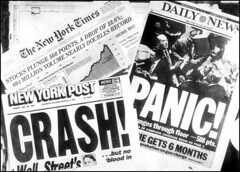End of print?
The Beatles would sing: I read the news today, o boy... The rumor goes (again) that the era of print has come to an end. Discovered in the Washington Post:
The venerable newspaper is in trouble. Under sustained assault from cable television, the Internet, all-news radio and lifestyles so cram-packed they leave little time for the daily paper, the industry is struggling to remake itself. (...)
The changes come as circulation totals have eroded steadily for nearly two decades and as newspapers no longer play the central role in daily life they once did. Newspaper executives argue that an emphasis on readership better reflects what newspaper companies are becoming -- multidimensional media conglomerates with growing Internet sites and stakes in television, radio, magazines and other businesses. (...)
"Print is dead," Sports Illustrated President John Squires told a room full of newspaper and magazine circulation executives at a conference in Toronto in November. His advice? "Get over it," meaning publishers should stop trying to save their ink-on-paper product and focus on electronic delivery of their journalism.
As advertising declines, newsrooms find it more difficult to afford overseas bureaus, extensive national operations and other editorial additions that help produce an authoritative daily report. As they cut back, they risk sending readers elsewhere for news, leading to further circulation declines and lower ad rates.
Adding to the industry's woes is the advent of new free sources of news, many of which appeal to younger readers and time-strapped families. Some papers, including The Washington Post, are trying to respond to the challenge by distributing free commuter tabloids, filled with abbreviated stories and entertainment news, as well as community papers. The Boston Globe's corporate parent, the New York Times Co., recently announced plans to buy a 49 percent stake in Metro Boston, a free paper that circulates in the New England city. (...)
Classified advertising, specifically help-wanted ads, is a bellwether of how newspapers are regarded as effective advertising tools. Increasingly, employers are using other resources to recruit workers.
Morgan Stanley estimated that, from 1998 through the end of last year, revenue generated by Internet help-wanted ads would grow 400 percent. During the same time, revenue from newspaper help-wanted ads was projected to drop 40 percent.
Many newspapers recognized the Internet's combination of threat and potential early on and have plowed hundreds of millions of dollars into Web sites of their own, hoping to keep readers, even if they don't leaf through the actual paper. (...)
The good news for newspaper Web sites is that, after the 2001 dot-com crash, Internet advertising has roared back, exceeding previous highs. Total Internet ad spending in the first six months of 2004 was 40 percent higher than in the comparable period in 2003, according to the Interactive Advertising Bureau. The sobering news? Internet advertising still accounts for only about 3 percent of total ad spending each year.
And not to forget: the threat of the blogs...











0 Comments:
Post a Comment
<< Home